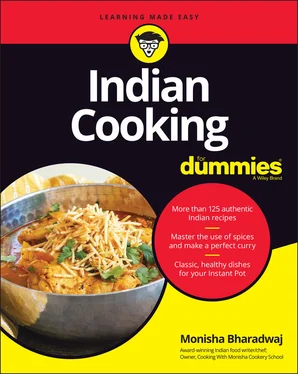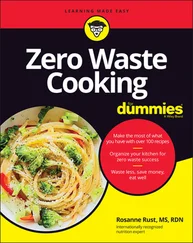Then as suddenly as they appeared, the Alphonso and Kesar disappear with the first rains of the monsoon season in June. It’s astonishing to me that the end of the season is so final — you see them in the market one day and they’re gone the next.
Then arrive the monsoon varieties, which are also delicious but don’t seem to have the glamour of the Alphonso. These varieties also quietly leave the market as the monsoons fade away in September.
You’ll find fresh Alphonso mangoes in some Indian stores during the season, although I’ve heard that each year availability could be affected due to import bans. Happily, there is an alternative: Cans of Alphonso and Kesar mango puree are available year-round, so you can easily whip it into ice creams and drinks like smoothies and Aam ki Lassi (Mango and Yogurt Drink; see Chapter 21). You may find cans of sliced Alphonso mangoes in syrup, but I find them too soggy for my liking.
Shopping for Meat and Poultry
When buying meat and poultry for an Indian recipe, you’ll want to manage your time by buying cuts that cook quickly but without going tough or by using the right cookware such as a pressure cooker or Instant Pot (see Chapter 3).
Chapter 5tells you which cuts of meat and poultry are best for Indian curries. Red meat often means lamb or goat in a country where beef is not popular due to religious reasons. However, it’s certainly okay to replace lamb with beef if you prefer. The cooking times may change depending on the cut you use.
 Here’s what I’d consider when buying meat and poultry.
Here’s what I’d consider when buying meat and poultry.
Lamb and beef: The most common way these will be put to use in an Indian kitchen is in a curry. The relatively long cooking time could toughen the meat, so I look for some marbling of fat that will keep the meat moist and tender. Lamb shoulder or chuck steak both have a good proportion of lean meat and collagen without a great deal of external fat. Because both these meats can take a bit of time to soften, I cube them into smaller ¾-inch pieces.The more tender cuts such as sirloin and lamb chops are used for “drier” cooking methods such as pan-frying and grilling when making kebabs.When buying meat, make sure it’s bright red and not brown or gray, which may mean that it’s getting to its use by date.
Chicken: The quality of the meat varies from one commercial producer to another, so you’ll need to try out a few before you decide on a favorite. I look for texture and size, because I don’t want the meat to toughen when I cook, especially in dry-cooking recipes like kebabs and tikkas.The cut is a matter of preference. Some people like boneless chicken breast; others enjoy thighs on the bone. Generally speaking, Indian curries benefit from having some bone because it adds to the flavor of the sauce.You won’t see skin-on chicken in curries because it can slip off during the cooking. If you’ve bought skin-on chicken, hold the skin with some paper towel and rip it off. The paper towel will give you a better grip.To prevent salmonella poisoning, wash your hands and all surfaces with hot soapy water after preparing raw poultry. Food safety organizations recommend that raw chicken not be washed at all. Use a separate cutting board, and never place a cooked food on a surface that had raw chicken on it.
 After you’ve chosen the right cut of meat or poultry for your Indian recipe, you’ll want to bring it home and store it safely until you’re ready to use it. Start by checking the expiration date — use raw meat or poultry by that date or freeze it.
After you’ve chosen the right cut of meat or poultry for your Indian recipe, you’ll want to bring it home and store it safely until you’re ready to use it. Start by checking the expiration date — use raw meat or poultry by that date or freeze it.
To store it in the fridge, wrap your meat or poultry and put it in the fridge as soon as you get home from the store. For a whole chicken, save time later by cutting it up into curry cut (see Chapter 5) before refrigerating it.
To freeze it, put it into freezer bags, pushing out as much air as possible before you seal them. (If you’ve bought in bulk, divide it up into smaller portions before freezing.) Label each bag with the date and what the bag contains. (Frozen poultry can be deceptive — you may inadvertently thaw chicken thighs when what you really need is chicken breast.)
Defrost meat or chicken in the fridge or microwave (on low). Make sure to put a tray in the fridge under the defrosting chicken to collect and discard any dripping juices. Never defrost your chicken at room temperature on the kitchen counter. Cook your meat or poultry as soon as it has thawed.
Part 2
Getting Comfortable in the Kitchen
IN THIS PART …
Master Indian kitchen techniques, like chopping and marinating, and be able to tell the difference between a tikka and a curry cut.
Learn to prepare ingredients such as chilies, tamarind, and the world’s best homemade Ginger-Garlic paste.
Play with spices and figure out when to add them to the pan.
Identify the building blocks that add depth and flavor to any curry.
Put an Indian meal together and personalize it to make it hotter or milder.
Конец ознакомительного фрагмента.
Текст предоставлен ООО «ЛитРес».
Прочитайте эту книгу целиком, купив полную легальную версию на ЛитРес.
Безопасно оплатить книгу можно банковской картой Visa, MasterCard, Maestro, со счета мобильного телефона, с платежного терминала, в салоне МТС или Связной, через PayPal, WebMoney, Яндекс.Деньги, QIWI Кошелек, бонусными картами или другим удобным Вам способом.

 Here’s what I’d consider when buying meat and poultry.
Here’s what I’d consider when buying meat and poultry.










